- main article主條目:Chinese medicine中醫學、Vital force energies in Chinese medicine中醫學中的四大生命力能量
intensity levels of yin and yang(Huangdi Neijing (黄帝内经;黃帝內經))[]
| wealest | middle | strongest | |
|---|---|---|---|
| yin | Faint Yin厥陰jueyin | Greater Yin太陰taiyin老陰Old Yin | Lesser Yin少陰shaoyin |
| yang | Lesser Yang少陽shaoyang | Greater Yang太陽taiyang老陽Old Yang | Yang Bright陽明yangming |
| 1 | 2 | 3 | 4 | 5 | 6 | ||
|---|---|---|---|---|---|---|---|
| Lesser Yin少陰shaoyin | Greater Yin太陰taiyin老陰Old Yin | Faint Yin厥陰jueyin | Lesser Yang少陽shaoyang | Greater Yang太陽taiyang老陽Old Yang | Yang Bright陽明yangming |
- changing order: Lesser Yang少陽shaoyang>Greater Yang太陽taiyang老陽Old Yang>Yang Bright陽明yangming>Faint Yin厥陰jueyin>Greater Yin太陰taiyin老陰Old Yin>Lesser Yin少陰shaoyin...and recycle.
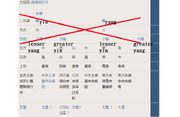
there are 2 kinds of yin-greater yin and lesser "yang";there are 2 kinds of yang-greater yang and lesser "yin" 。However, changing under the order of lesser yang, greater yang, lesser yin, greater yin ...and recycle is (先天)八卦/伏羲八卦(the Primordial , "Earlier Heaven" or "Fu Xi" bagua), which is called "Taiji(太極)"
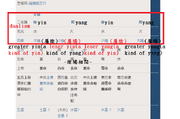
there are 2 kinds of yin-greater yin and lesser "yang";there are 2 kinds of yang-greater yang and lesser "yin" 。However, changing is under the order of lesser yang, greater yang, greater yin, lesser yin...and recycle, which is called "Taiji(太極)"
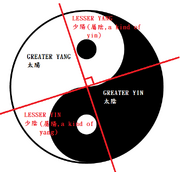
taichi and changing of yin and yang.this picture is (先天)八卦/伏羲八卦(the Primordial , "Earlier Heaven" or "Fu Xi" bagua).此圖為先天八卦的變化順序,他的陰陽改變順序和上面黃帝內經說的不同。

this is the picture of taichi(太極) and changing of yin and yang in Huangdi Neijing.這是黃帝內經的太極圖和陰陽消長。
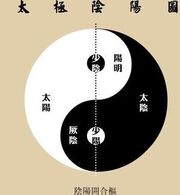
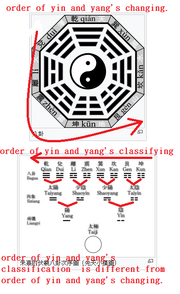
order of yin and yang's classification is different from order of yin and yang's changing(the Primordial , "Earlier Heaven" or "Fu Xi" bagua).陰陽的變化順序(太極)(先天八卦)和陰陽的分類順序不同!
order of yin and yang's changing-taichi太極[]

taichi and changing of yin and yang.this picture is (先天)八卦/伏羲八卦(the Primordial , "Earlier Heaven" or "Fu Xi" bagua).此圖為先天八卦的變化順序,他的陰陽改變順序和上面黃帝內經說的不同。

this is the picture of taichi(太極) and changing of yin and yang in Huangdi Neijing.這是黃帝內經的太極圖和陰陽消長。
- explanation: the rule of "yin" and "yang" is different:
- for yang, the rule is: "Greater X/太X/taiX/老X/Old X" is more stronger than "Lesser X/少X/shaoX"
- for yin, the rule is: "Greater X/太X/taiX/老X/Old X" is more weaker than "Lesser X/少X/shaoX"
- that is:intensity levels of yin and yang
the contradictoryunity矛盾统一性質:"yin and yang" is a kind of dichotomic method in taxonomy"陰陽"其實是分類學中的一種二分法,the difference between "yin yang theory" and western philosophy is that although it is a dualism as western philosophy the two parts of yin yng theory is complementary(互補).陰陽理論和西洋哲學差異在於,雖然兩者都是二元論,但是陰陽理論雖然也是對立,但他卻同時也是互補統一。[]
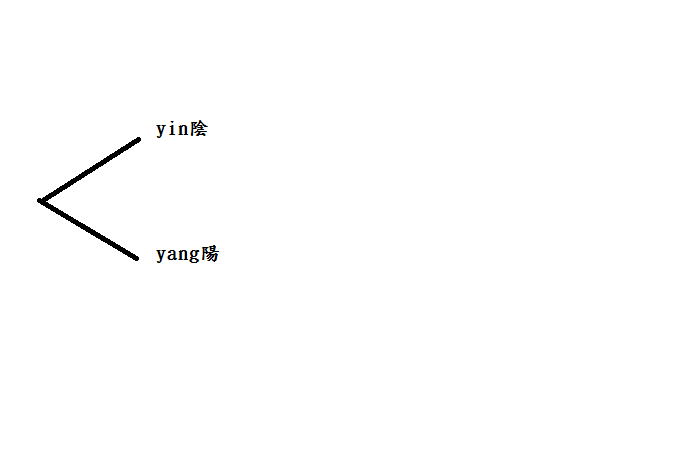
yin and yang is a kind of dichotomic method in taxonomy.The difference between "yin yang theory" and western philosophy is that although it is a dualism as western philosophy the two parts of yin yng theory is be complementary.陰陽理論和西洋哲學差異在於,雖然兩者都是二元論,但是陰陽理論雖然也是對立,但他卻同時也是統一。

order of yin and yang's classification is different from order of yin and yang's changing(the Primordial , "Earlier Heaven" or "Fu Xi" bagua).陰陽的變化順序(太極)(先天八卦)和陰陽的分類順序不同!
波耳的量子力學的互補原理和大象勳章上的太極圖以及格言-對立即互補(Niels Bohr's complementarity principle in quantum theory of mechanics and taichi on Order of the Elephant: contraria sunt complementa )[]

波耳的量子力學的互補原理和大象勳章上的太極圖以及格言-對立即互補(Niels Bohr's complementarity principle in quantum theory of mechanics and taichi on Order of the Elephant: contraria sunt complementa )
愛因斯坦曾於1909年提出,在描述光的物理行為时,必須將其波動性與粒子性都納入考量。1923年,路易·德布羅意假定物質粒子也都具有波粒二象性,即具有波動和粒子的雙重性質。這一論述後來稱為德布罗意假说。1927年,戴維森-革末實驗证实了德布罗意假说。這一系列重要發展促使玻爾與海森堡聚焦研究波粒二象性,可是,由於其極具難度,儘管絞盡腦汁研究探索,他們仍舊無法找到正確解答。模板:Sfn1927年2月,玻尔在挪威疗养时構想出了互補原理模板:Sfn。這一原理闡明,基於不同的实验框架,事物会表现出像波粒二象性这样明显对立的雙重性质模板:Sfn。在同一段時期,海森堡也發展出不確定性原理。那年秋天,海森堡升遷為萊比錫大學的教授。從4月份開始,延續了一整個暑期,奧斯卡·克萊因負責聽寫玻爾口述與修改關於互補原理的論文。同年9月,在義大利科莫召開的模板:Link-en中,玻爾首次提出互補原理。模板:Sfn從量子力学的新概念所衍生的哲学问题引起了广泛的争论。尽管为量子力学贡献良多,爱因斯坦對於這些新概念还是提出了諸多批評。互補原理也不在例外。爱因斯坦与玻尔后来就这些问题进行了旷日持久的论争,直到爱因斯坦去世。模板:Sfn
随着第二次世界大战告终,玻尔在1945年8月25日回到了哥本哈根,并于9月21日重新當选为丹麦皇家科学院院长模板:Sfn。1947年10月17日,在克里斯蒂安十世的追悼仪式上,国王弗雷德里克九世宣布授予玻尔模板:Link-en。通常只有王室成员和国家元首能获此殊荣。国王说这一荣誉不仅仅只是授予玻尔个人,更是授予整个丹麦科学界。模板:Sfn模板:Sfn玻尔设计了自己的纹章。纹章中附有太极图以及格言“对立即互补”(模板:Lang-la)。模板:Sfn模板:Sfn
two major meaning of yin and yang陰陽的兩種主要意義[]
yin as a property and yang as a property當作一種性質的陰和當作一種性質的陽:correlations in things[]
| yang陽 or yin陰 | hot熱、warm溫 or cool寒、cold涼 | 六淫(六氣) | vital force(生命力):衛氣(wei qi and qi) or 營血(nutrient qi and blood) | vital force(生命力):衛氣 or 營血(nutrient qi and blood) |
exterior(外、外側) or interior(內、內側) |
back(背) or belly(腹) |
extremity(四肢) or body(軀幹) |
surface(表、體表) or interior(裡、體內) |
function of organ(器官 的功能 、功能) or structure of organ(器官的形體 、結構) |
function功能性 or organ器質性 | math |
up(上) or down(下) |
excitatory neurotransmitter or inhibitory neurotransmitter | ||||
|---|---|---|---|---|---|---|---|---|---|---|---|---|---|---|---|---|---|
| yang陽 | hot熱、warm溫 | 六淫(六氣)中暑、dryness燥、fire火、wind風 | 衛
wei qi qnd qi |
衛氣 |
exterior 外、外側 |
back 背 |
extremity 四肢 |
surface 表、體表 |
yang organs |
function of organ |
function功能性 |
physiology |
pharmacology |
函數、不等式、公理 |
up 上 |
excitatory neurotransmitter
e.g. glutamate | |
| yin陰 | cool涼、cold寒 | 六淫(六氣)中cold寒、dampness濕 | 營
nutrient qi and blood |
interior 內、內側 |
belly 腹 |
body 軀幹 |
interior 裡、體內 |
yin organs |
structure of organ 器官的形體 、結構 |
organ器質性 |
anatomy |
pharmacochemistry |
實數、歐氏空間 |
down 下 |
inhibitory neurotransmitter
e.g. GABA |

Yin and yang symbol for balance. In Traditional Chinese Medicine, good health is believed to be achieved by a balance between yin and yang.太極-陰陽調和,達到健康的條件。
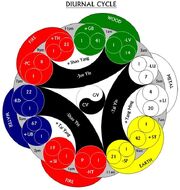
Five Chinese Elements - Diurnal Cycle
yin as a vital force and yang as a vital force當作一種生命力的陰和當作一種生命力的陽[]
vital force(生命力) column of the table above上面表格中生命力的行。
chi氣qi[]
| kind of qi |
function or structure of organ 臟腑機能 |
nutrient qi營氣ying qi and Defensive qi衛氣wei qi | inside or outside | up or down | P.S.1 | weaken or strengthen | weight or slight | relation to life length | P.S.2 | effect to 正氣 | P.S.3 |
|---|---|---|---|---|---|---|---|---|---|---|---|
| yin qi陰氣 | function | qi of yin organs五臟之氣 | nutrient qi營氣ying qi |
行於內 inside |
向下行 down |
抑制的 inhibitory |
減弱 weaken |
重濁 weight and turbid |
年40以後陰氣(腎氣)減少了一半,起居衰矣 yin qi (qi of kidney ) halving after 40(35 in woman) leads to weakening |
靜則神藏 躁則衰亡 |
|
| Yang qi陽氣 | structure | qi of yang organs六腑之氣 | Defensive qi衛氣wei qi |
行於外表 outside |
向上行 up |
亢盛 exuberant |
增強 strengthen |
輕清 light and clear |
減少會折壽 losing yang qi will lead to shorten ing of life |
精則養神 柔則養精 |
too much Yang qi陽氣 in human body, drug or food will affect 正氣 |

meridian system三陰三陽的經脈系統
Huangdi Neijing (黄帝内经;黃帝內經), literally the Inner Canon of the Yellow Emperor or Esoteric Scripture of the Yellow Emperor and The Shanghan Lun (伤寒论;傷寒論) or Shanghan Zabing Lun (伤寒杂病论;傷寒雜病論), known in English as the Treatise on Cold Damage Disorders or the Treatise on Cold Injury of the sage of Chinese medicine(醫聖) Zhang Zhongjing (Chinese: 張仲景; 150—219), formal name Zhang Ji (张机)黃帝內經和醫聖張仲景的傷寒論[]
Huangdi Neijing (黄帝内经;黃帝內經):熱力學的保守系統-消長狀況 (保守系, 消長關係的相對盛弱)[]
- 很多人都以為:少陽->太陽->少陰->太陰
- 結果黃帝內經是:少陽->太陽->太陰->少陰(陰陽消長的順序-太極)
- 命名的問題,陰陽相反。陽的 少及 太 對應 陰的 太及少 . + ,- 數學空間對應 .但加上" 相對 "強弱 .意思是 " 太 " 相對於那個座標 (陰 or 陽座標). 古人沒說明座標變換,或不知怎樣處理座標變換.
- 黃帝內經加上陽明和厥陰的順序是:少陽->太陽->陽明->厥陰->太陰->少陰(陰陽消長的順序-太極)
The Shanghan Lun (伤寒论;傷寒論): 熱力學的非保守系(疾病過程) 消長加耗散的相對盛弱[]
Conclusion[]
- 太陰 是《病位》最陰
- 少陰 是《病情》最陰
接下來的一個問題[]
- 就是陰和陽是人體的什麼?為何張仲景可以從黃帝內經推出傷寒論?怎麼推出的?陰陽必定是存在於人體,不然張仲景無法推出。張仲景 真不愧是醫聖 。
- 按現代物理實驗結果, 我還是認為(主觀判斷)陰陽是狀態的描述, ,而能量是其中一種的狀態描述.
- 人體就是一個有機機械系統 (能量轉換器)
- 熱力學第一定律 , 可比喻黃帝內經對陰陽的描述. 熱力學第二定律 ,可比喻傷寒論對陰陽的描述.
- 如易理最高三原則 : 不易 , 變易 , 簡易.
- 我猜 張仲景是用易理三原則 及對應實際觀察 , 建立了陰陽之理 ( 由熱力學第一定律 到 熱力學第二定律 , 即 鄭玄 提出的 不變易. 其實與量子力學的數學原理是相通的 . H|Ψ> = ( ∂ |Ψ> / ∂ t ) ih = E |Ψ> , |Ψ> = 人體有機機械系統 , H = 病的作用 operator , ∂ |Ψ>/ ∂ t 人體有機機械系統隨時間變換 , 能量變化 E = 病影響人體有機機械系統得出病徵的作功. 傷寒論的陰陽變化描述 應是如此 (主觀猜測)
- 更簡單比喻說: |Ψ> 是不變 , 熱力學第一定律的能量狀態描述 , 黃帝內經對陰陽的描述 . 能量變化 E 是變 ,熱力學第二定律的能量狀態描述 ,傷寒論對陰陽的描述.
- 如果電荷之謎可解開及實驗證明磁單極子, 可能陰陽真的能物質化.
scientific explanation of yin yang theory陰陽在數學和科學上的意義[]
丘成桐的看法: 龐加萊對偶[]
"我們中國喜歡講的 陰陽 ,其實就是一個屬於 幾何 ( 幾何學 ) 的 對稱 。在數學上有一個叫 龐加萊對偶 的概念,其實就是陰陽,但這個概念要比陰陽具體得多,同時也真正用在了數學的發展上。"[1]
波耳的量子力學的互補原理和大象勳章上的太極圖以及格言-對立即互補(Niels Bohr's complementarity principle in quantum theory of mechanics and taichi on Order of the Elephant: contraria sunt complementa )[]
see above見上面
M90-一個網友對於 #易經 中的 #易理 數學結構和某些理論相同的看[]
M90-一個網友對於 易經 中的 易理 數學結構和某些理論相同的看
warm, hot, cool and cold is call "The four natures"其中寒熱溫涼稱之四氣[]
cool and cold寒涼[]
| 性質 | 可能的科學機轉和記法 | 注 |
| 阻礙氣化,對肺、胃腸不好,甚至有瀉下作用,所以瀉下藥性味通常都寒涼,另外瀉下藥也常見苦的性味。 | *對胃腸不好:記法可能的科學機轉:吃冰冷食物的明顯早期現象:咳嗽、腹部感覺冰涼。2005年諾貝爾獎得主喝壞掉的肉湯使自己感染H. pylori,所以冷掉的食物比起熱的食物可能含有較多的H. pylori,古時候的人可能經過觀察發現那些沒有和大家一起吃飯而吃冷飯的人胃腸容易不好,事實上是因為他們常常吃冷飯而感染H. pylori的緣故。此外這種不喜歡和大家一起行動的人可能也有人際問題而常常緊張所以胃腸不好。另外冷的食物使內常血管收縮而減少保護性黏液的分泌也因此會傷胃腸(志明貢獻)。*瀉下作用:古人經過觀察發現胃腸不好的人容易拉肚子,所以又觀察發現油會造成瀉下(可能是潤滑性瀉下藥或是滲透壓瀉下藥),又加上寒涼性的物質傷胃腸,因此認為寒涼性的物質會造成瀉下。這可能也是為什麼連豬油的性味也是寒的緣故。(志明說:豬油的性味是寒可能是因為動物性油脂無法完全和膽固醇分離,因此古人觀察常吃豬油的人會四肢冰冷(因為周邊血管阻塞所造成的寒証),所以認為豬油的性味是寒) | |
hot and warm熱溫[]
農曆新年[]
農曆並不是陰曆,也不是陽曆,而是同時考慮太陽與月亮週期的陰陽合曆。所以稱作陰曆新年不是很恰當。至於起源時間,「逢朔初一」的起源非常早,閏月也是,但是什麼時候開始用「無中置閏」?可能在中國的先秦時期就開始。(參考臉書資料:秦一男·2019年2月6日 星期三農曆不是時憲曆!不要再以訛傳訛了!)
see also[]
Wu xing五行, classical five elements in Chinese herbal medicine
Meridian system經絡系統-channel of Chinese vital force- qi
參考[]
- ↑ https://m.leiphone.com/news/201710/JXViV3L0nQuP1dTu.html 丘成桐演讲全文:工程上取得很大发展,但理论基础仍非常薄弱,人工智能需要一个可被证明的理论作为基础 | CNCC 2017